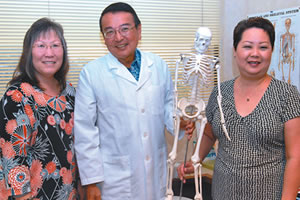General Orthopedic Care
Interviewed by Melissa Moniz
Wednesday - February 25, 2009
E-mail this story | Print this page | Comments (0) | Archive
 Del.icio.us Share
Del.icio.us Share

Dr. James Oda
Orthopedic Surgeon
Interviewed by Melissa Moniz
Where did you receive your schooling and training?
I graduated from University High School and then received a bachelor’s degree in government from Georgetown University. Since my father was a lawyer in Honolulu, I initially intended to get a law degree, but while at Georgetown I changed my mind. I went instead to Washington University School of Medicine in St. Louis, Mo. After receiving my MD degree, I received two years of training in general surgery at the University of California, San Francisco, then I did my orthopedic surgery training in the University of Hawaii program, which was headed at that time by Dr. Ivar Larson.
Do you have an area of specialty?
In 1976, when I finished my orthopedic training, fellowships in the sub-specialties of orthopedics such as in pediatrics, spine, hand and joint replacements did not exist. The general orthopedists at that time treated all orthopedic problems. Medicine has changed over the past 33 years, and currently most orthopedists do special training in these and other areas. I treat general problems such as broken bones, back and neck pain, and joint pain. Special problems are usually referred, at discretion of the general orthopedic surgeon, to those with specialized training. When I was an intern and general surgery resident in San Francisco, I worked under Dr. William Murray, who was one of the early pioneers in total hip and total joint replacement. I’ve maintained an interest in that facet of orthopedics throughout my career.
Do you have patients of all ages?
When I first began practice, orthopedists used to see everyone from infants to elderly individuals. With the development of the pediatric orthopedic sub-specialty, general orthopedists like myself see mainly adults over the age of 18. I still see children, but not as many as I did earlier in my career.
What are some of the most common orthopedic problems that you treat?
The treatment of broken bones from falls and motor vehicle accidents represents a significant part of an orthopedic surgery practice. Wrist fractures, hip fractures and compression spine fractures due to osteoporosis tend to be very common in women past the age of menopause. These fractures are often a result of osteoporosis (loss of calcium in the bone and resulting tendency to easily break). Degenerative arthritis involves a process of a joint wearing out and resulting in pain and decreased mobility. Today, joint replacement surgery is done on most major joints of the body. The more common joints are the shoulders, hips and knees, but we also replace elbows, ankles and small joints in the hand. Neck pain and lower back pain from muscle injuries, ruptured disc and arthritis are often conditions seen in the office. Tendonitis in the shoulders, wrists, elbows and ankles also are common along with nerve problems such as carpal tunnel syndrome, and foot deformities such as bunions are also treated in an orthopedic surgeon’s office.

Of the injuries you see, which are preventable?
The most common preventable injuries we see are fractures of the hip, wrist and spine due to osteoporosis. For women over the age of 50, the lifetime risk of vertebral fracture is 1 in 3, and the lifetime risk of a hip fracture is 1 in 6. We now have medication to treat osteoporosis by decreasing bone calcium loss, thus making the bone stronger. Preventing falls, of course, is the simplest way to prevent injuries, and toward that goal identifying risk factors such as muscle weakness, abnormalities in gait or balance, poor vision, decrease in sensation in the lower extremity and side effects of medication are important. Patients with an abnormal gait or muscle weakness may require an assistive device such as a cane or walker to improve mobility. Exercise programs such as tai chi and physical therapy can improve balance, muscle strength and flexibility. For high-risk patients, the use of soft material flooring and hip protectors can prevent serious injuries.
Many athletic injuries can be decreased by good pre-participation examination and proper conditioning. Bracing areas such as the wrist and knee in certain sports also decreases injuries. Using a back brace to prevent lower back injuries is somewhat questionable.
What about wear and tear? Are there things that can be done to slow down that process?
Proper nutrition is necessary to help prevent the breakdown or articular cartilage in joints. A person needs protein to maintain muscle mass and joint articular cartilage. Supplements may be needed for the elderly.
What about calcium? Does that help keep your bones stronger and healthier?
Adequate calcium and vitamin D are needed to maintain bone health. Daily calcium intake of 1,500 milligrams is recommended for adults. For measuring bone mass, a DEXA bone scan is currently the most popular.
Beside your private practice, what else are you involved in?
My other main activity involves participation in the medical executive committee of the Rehabilitation Hospital of the Pacific (REHAB). Dr. Myron Shirasu was the chief of staff 15 years ago and asked me to join the executive committee. I’ve just finished six years of being chief of staff at the hospital, and I still serve on several other committees, such as the Credentials and the Peer Review committees.
E-mail this story | Print this page | Comments (0) | Archive
Most Recent Comment(s):













